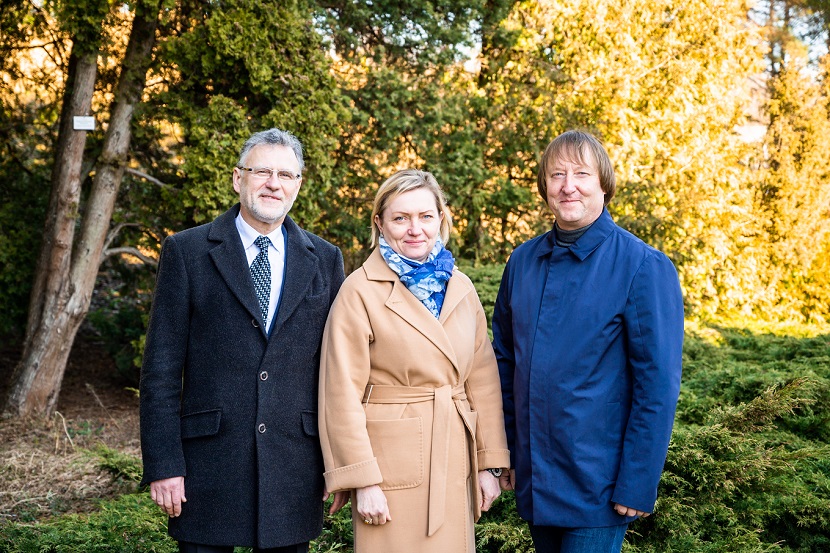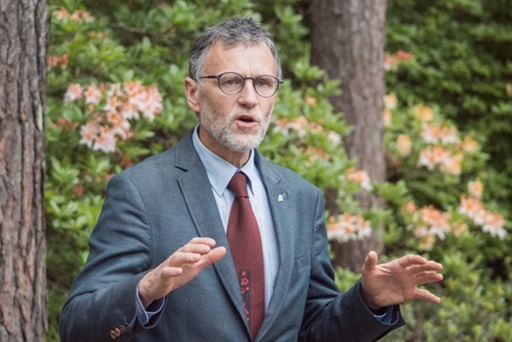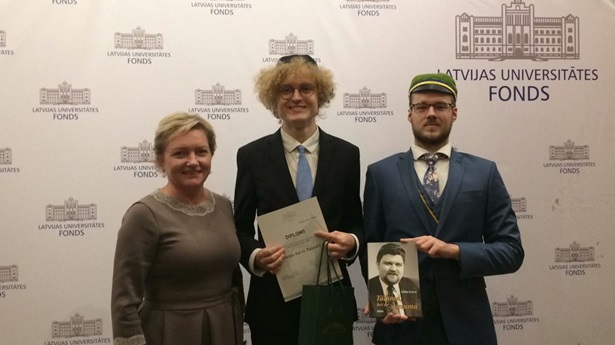
We are delighted to announce that VENDEN has started a close cooperation with the Botanical Garden of the University of Latvia (UL) and will be its information partner in 2022. We have undertaken this cooperation within the framework of the centenary celebration of the Botanical Garden of the University of Latvia to help collect donations for the revitalization of the linden alley ensemble of the botanical garden. Meanwhile, we will provide various gifts to visitors, install an environmental object in the garden and offer other surprises.
VENDEN has been developing the vision of a green brand for many years and is persistently taking various initiatives to preserve and improve the environment and nature. The linden alley of the botanical garden is essential both from the viewpoint of the ecosystem and its cultural and historical value; nonetheless, it is crucial to carry out restoration works so that it maintains its aesthetic value.
To find out more about the importance of the linden alley and how crucial it is to preserve it, we have invited Uldis Kondratovičs, director of the Botanical Garden of the University of Latvia, and Laila Kundziņa, executive director of the University of Latvia Foundation, to an interview. Read on and find out more!
Uldis Kondratovics, the director of the Botanical Garden of the University of Latvia, says:” Somehow it has happened that my life has led me back to the Botanical Garden. And I say 'led me back' because I practically lived in it for the first ten years of my life. The comeback is related to the performance of work duties and not to the carefree childhood, so I see the Garden in a different light. It is no longer full of mysterious corners, jungles, and steep hill slopes, but rather real challenges. I was born into a family of biologists. Both my parents and my sister are biologists. I studied biology at the University of Latvia, where I also wrote and defended my doctoral thesis, so nature is very close to me. I feel very attached to the Botanical Garden because I have seen it change, grow old, and renew all life long, and it is a great pleasure that I can actively participate in these transformations myself. This year, the Botanical Garden of the University of Latvia celebrates its centenary, and everyone who takes care of it on a daily basis including gardeners, scientists, and technicians has a lot of work. In the centenary of the Botanical Garden, I would like to thank everyone, especially its supporters, patrons, and other benefactors for appreciating us both with support and presence, as our mission is and remains to preserve the diversity of live nature, giving everyone the opportunity to explore it and acquire knowledge in it.
What are the benefits of preserving the linden alley ensemble in the Botanical Garden of the University of Latvia?
1. Reduction of CO2 emissions
Trees absorb CO2 from the air during the process of photosynthesis and release oxygen, thus reducing total CO2 emissions. As green filters, they can absorb up to 70% of air pollutants from the air. The collection of dendroflora in the Botanical Garden of the University of Latvia reduces climate change by absorbing ~ 25,000 kg of CO2 per year.
2. Microclimate improvement
Trees in gardens, parks, squares, and streets improve the microclimate. During the summer, they allow to maintain a moderate air temperature, but in winter they protect from cold winds. The foliage and root system of the trees absorb a large part of the precipitation, thereby relieving the drainage systems. Leaves also act as an excellent dust trap. One square meter of leaf surface absorbs 1.5 - 10 grams of dust, and they get washed away every time it rains. The foliage also reduces city noise by up to 10 decibels.
3. Ecological value in the conservation of biodiversity
Old trees have a historical and ecological value, especially in urban areas. Damaged and old trees do not need to be cut down. Instead, they need to be taken care of and given the opportunity to live for decades to come because trees that provide shelter for other species are crucial to nature. The older a tree gets, the more space in its foliage, branches, and trunk can provide for countless organisms.
Large, mature, but well-groomed trees that have reached their maximum size give more shadow and are creators of a distinct landscape. Large and old trees also provide more diverse shelter for other living creatures such as birds, insects, bats, lichens, mosses, and fungi. Massive trees that are recognized as natural monuments are protected by Latvian legislation.
4. Preservation of natural and cultural heritage
The set of trees of the Dutch linden alley ensemble of the botanical garden forms a system of greenery and is the city's cultural and historical heritage. It is an integral part of a recreational environment in which new knowledge can be acquired.
5. Sustainable urban management
Trees produce compostable waste, which can be recycled back to enrich the soil and thus improve the growing conditions for plantations in the Botanical Garden. While caring for the trees, dry branches are obtained, which, when crushed, can be used to get valuable branch chips. These woodchips can be used for mulching planting areas and improving the quality of the soil.
How often will further care for lindens be required, and what are the approximate costs of renovating and maintaining the linden alley over the next five years?
After this kind of tree maintenance work, fundamental care will not be required for 3-5 years, unless the condition of the trees deteriorates significantly due to weather conditions or other harmful factors. After winds, which are stronger than 18 m/s, the responsible workers of the Botanical Garden inspect the trees themselves (not only in the alley) and assess their condition - whether or not any significant damage has been caused. Henceforward, dynamic stabilizer links which are now placed in some trees of the linden alley ensemble must be looked after because they can not be tensioned.
After 3-5 years, specialists (certified arborists) should be invited to inspect the alley trees to obtain recommendations for future care work, if it will be necessary. It is currently not possible to predict the costs. At this moment, the trees of the linden alley ensemble have been taken care of, and only time will tell what actions will be needed in ~ 5 years and how much it will cost.
In what other ways can patrons contribute to the needs of the University of Latvia Botanical garden?
· reconstruction of the plant house complex,
· care and restoration of garden trees;
· renovation of the garden equipment park,
· revitalization of Wolfschmidt manor buildings,
· reconstruction of the historical ice cellar,
· improvement of the exhibition and event center,
· reconstruction of rhododendron plantations,
· creation of a formal garden near the buildings of Wolfschmidt manor.
What would you wish for each patron?
I wish every donor joy and satisfaction from charity, realizing that the Botanical Garden as the Green Pearl of Riga is a place for people in the urban environment to learn about live nature. It also works as a refuge from the stress and rush of life.
Laila Kundziņa, executive director and member of the board of the University of Latvia Foundation, says: “I have been a part of the University of Latvia Foundation for 13 years. Presently, my biggest hobby, besides traveling, is writing a doctoral thesis. The topic of my work is ‘Trends in acquiring funds by public universities’ and I research the foundations and associations of 12 universities, that have had public benefit organization status in the period from 2011 to 2021. I usually say that it is a science-based espionage project. In the study, I will offer three scenarios so that the funds established by universities can improve the fundraising trends. I will definitely share the results of my research in order to increase the flow of donations in support of higher education.”
Why is it important to donate?
The tradition of donation dates back to ancient Greece when wealthy citizens supported cultural and artistic initiatives. The first known donor was Gaius Cilnius Maecenas, and since then, donors have been called maecenas. It is the desire to support specific projects and initiatives that guarantees the well-being of society. Donations improve the quality of life in society. Since 2005, the UL Foundation has been trusted by more than 4,000 people and companies with donations of various amounts. Donors who donate up to 7,000 euros are considered by the LU Foundation as supporters, but donors who donate over 7,001 euros – as patrons. In total, more than 2,000 students have received scholarships ranging from 150 euros per month to 1,400 euros per month. With the support of the patrons of the University of Latvia Foundation, more than 70 different projects have been supported.
What does the renewal of this linden alley and donations mean to the University of Latvia Foundation?
The University of Latvia Foundation has administered several donations which are aimed at improving the Botanical Garden of the University of Latvia. Because of the donation that JSC “MADARA Cosmetics” made in December 2021 in the amount of 10,000 euros, the linden alley ensemble was weeded, so the first stage of the weeding process has been realized. It was completed at the end of March 2022. It is a nice feeling when you have managed to attract a patron who has similar values to the University of Latvia and the University of Latvia Foundation - the desire for excellence; it gives satisfaction to cooperate with the patron.
What are the funding opportunities that the UL Foundation offers to patrons?
The UL Foundation operates similarly to the foundations of the world's most prestigious universities. There are three possible ways to support by donationg: scholarships for students, learning environment improvement projects, and infrastructure projects. Projects that can be supported by any patron can be viewed here: https://issuu.com/universitate/docs/priek_likumu_portfelis_2021_
What would you wish for each patron?
I wish every donor good health, vigor, optimism, and successful achievement of their goals!

Opening of the Cognitive Trail at the Experimental and Breeding Nursery of Rhododendrons “Babite” dedicated to Rihards Kondratovics, professor of the University of Latvia, and his lifetime work in rhododendron breeding, 2019

Laila Kundzina together with the representatives of “Lettonia” on the day of honoring the scholarship holders, 2018